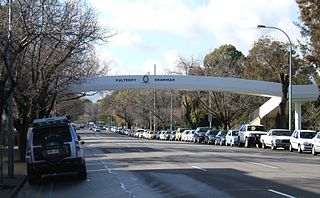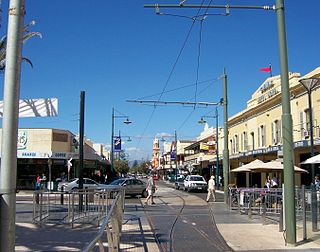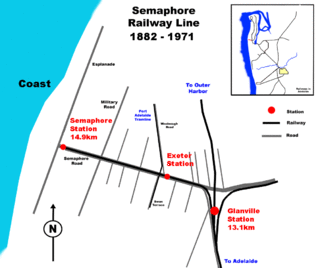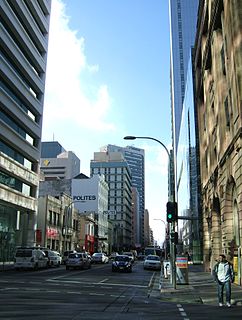The Glenelg tram is a light rail line in South Australia running from Hindmarsh, through the Adelaide city centre, to the beach-side suburb of Glenelg. It is Adelaide's only remaining tramway. Apart from short street-running sections in the city centre and Glenelg, the line has its own reservation, with minimal interference from road traffic.

Light rail, light rail transit (LRT), or fast tram is a form of urban rail transit using rolling stock similar to a tramway, but operating at a higher capacity, and often on an exclusive right-of-way.

South Australia is a state in the southern central part of Australia. It covers some of the most arid parts of the country. With a total land area of 983,482 square kilometres (379,725 sq mi), it is the fourth-largest of Australia's states and territories by area, and fifth largest by population. It has a total of 1.7 million people, and its population is the second most highly centralised in Australia, after Western Australia, with more than 77 percent of South Australians living in the capital, Adelaide, or its environs. Other population centres in the state are relatively small; Mount Gambier, the second largest centre, has a population of 28,684.

Hindmarsh is an inner suburb of Adelaide, South Australia. It is located in the City of Charles Sturt.
The service is free between the Adelaide Entertainment Centre in Hindmarsh and South Terrace in the city centre, and along the entire length of Jetty Road, Glenelg to Moseley Square. In addition to the main route from the Adelaide Entertainment Centre to Moseley Square, a shuttle service is provided within the free city zone between the Adelaide Entertainment Centre and South Terrace.

The Adelaide Entertainment Centre (AEC) is an indoor arena located in the South Australian capital of Adelaide. It is used for sporting and entertainment events. It is the principal venue for concerts, events and attractions for audiences between 1,000 and 11,300.

South Terrace is one of the four terraces which bound the city centre of Adelaide, the capital of South Australia.

Jetty Road in Glenelg is a major tourism and retail precinct in South Australia. Starting from Brighton Road, it is almost 1 kilometre long. At its western end is Moseley Square and the popular Glenelg beachfront.
A 1.6 kilometre northern extension through the city centre opened on 14 October 2007, extending the line from Victoria Square along King William Street and North Terrace to Morphett Street. A further 2.8 kilometre north western extension of the line along Port Road to the Adelaide Entertainment Centre opened on 22 March 2010. Construction of a one kilometre branch line along the eastern end of North Terrace and a single-stop 100 metre branch line along King William Road began in July/August 2017 and, following a series of delays, opened on 13 October 2018.

Victoria Square, also known as Tarntanyangga or Tarndanyangga, is a public square in the South Australian capital of Adelaide. The area was named "Victoria Square" by the Street Naming Committee on 23 May 1837, after Princess Victoria, then heir presumptive of the British throne. Less than a month later the King died and Victoria became Queen. The Kaurna people know the area as Tarndanyangga, "The Dreaming Place of the Red Kangaroo". In line with the Adelaide City Council's recognition of Kaurna country, the area is officially referred to as Victoria Square/Tarndanyangga. The square was upgraded in 2014, new lighting was added and the fountain was moved from the northern end to the southern tip of the square. During the Christmas period, it is traditional for a 24.5 m high Christmas tree to be erected in the northern part of the square.

King William Street is the part of a major arterial road that traverses the CBD and centre of Adelaide. It was named by the Street Naming Committee on 23 May 1837 after King William IV, the then reigning monarch, who died within a month. King William Street is approximately 40 metres (130 ft) wide, and is the widest main street of all the Australian State capital cities, which are significantly narrower by comparison. It is historically considered one of Adelaide's high streets, for its focal point of businesses, shops and other prominent establishments.

North Terrace is one of the four terraces that bound the central business and residential district of Adelaide, the capital city of South Australia. It runs east-west, along the northern edge of "the square mile". The western end continues on to Port Road, and the eastern end continues across the Adelaide Parklands as Botanic Road.























